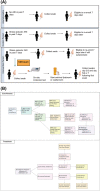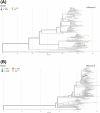Results from a test-and-treat study for influenza among residents of homeless shelters in King County, WA: A stepped-wedge cluster-randomized trial
- PMID: 36610058
- PMCID: PMC9835442
- DOI: 10.1111/irv.13092
Results from a test-and-treat study for influenza among residents of homeless shelters in King County, WA: A stepped-wedge cluster-randomized trial
Abstract
Background: Persons experiencing homelessness face increased risk of influenza as overcrowding in congregate shelters can facilitate influenza virus spread. Data regarding on-site influenza testing and antiviral treatment within homeless shelters remain limited.
Methods: We conducted a cluster-randomized stepped-wedge trial of point-of-care molecular influenza testing coupled with antiviral treatment with baloxavir or oseltamivir in residents of 14 homeless shelters in Seattle, WA, USA. Residents ≥3 months with cough or ≥2 acute respiratory illness (ARI) symptoms and onset <7 days were eligible. In control periods, mid-nasal swabs were tested for influenza by reverse transcription polymerase chain reaction (RT-PCR). The intervention period included on-site rapid molecular influenza testing and antiviral treatment for influenza-positives if symptom onset was <48 h. The primary endpoint was monthly influenza virus infections in the control versus intervention periods. Influenza whole genome sequencing was performed to assess transmission and antiviral resistance.
Results: During 11/15/2019-4/30/2020 and 11/2/2020-4/30/2021, 1283 ARI encounters from 668 participants were observed. Influenza virus was detected in 51 (4%) specimens using RT-PCR (A = 14; B = 37); 21 influenza virus infections were detected from 269 (8%) intervention-eligible encounters by rapid molecular testing and received antiviral treatment. Thirty-seven percent of ARI-participant encounters reported symptom onset < 48 h. The intervention had no effect on influenza virus transmission (adjusted relative risk 1.73, 95% confidence interval [CI] 0.50-6.00). Of 23 influenza genomes, 86% of A(H1N1)pdm09 and 81% of B/Victoria sequences were closely related.
Conclusion: Our findings suggest feasibility of influenza test-and-treat strategies in shelters. Additional studies would help discern an intervention effect during periods of increased influenza activity.
Keywords: antiviral treatment; homeless shelters; influenza; randomized control trial; rapid molecular influenza test.
© 2023 The Authors. Influenza and Other Respiratory Viruses published by John Wiley & Sons Ltd.
Conflict of interest statement
Dr. Chu reported consulting with Ellume, Pfizer, The Bill and Melinda Gates Foundation, GlaxoSmithKline, and Merck. She has received research funding from Sanofi Pasteur, and support and reagents from Ellume and Cepheid outside of the submitted work. Dr. Englund reported research support from Merck, AstraZeneca, Pfizer, and GlaxoSmithKline. She is a consultant for Meissa Vaccines, Sanofi Pasteur, and AstraZeneca.
Figures



Similar articles
-
Point-of-care molecular testing and antiviral treatment of influenza in residents of homeless shelters in Seattle, WA: study protocol for a stepped-wedge cluster-randomized controlled trial.Trials. 2020 Nov 23;21(1):956. doi: 10.1186/s13063-020-04871-5. Trials. 2020. PMID: 33228787 Free PMC article.
-
Efficacy of oseltamivir treatment started within 5 days of symptom onset to reduce influenza illness duration and virus shedding in an urban setting in Bangladesh: a randomised placebo-controlled trial.Lancet Infect Dis. 2014 Feb;14(2):109-18. doi: 10.1016/S1473-3099(13)70267-6. Epub 2013 Nov 22. Lancet Infect Dis. 2014. PMID: 24268590 Clinical Trial.
-
Care-seeking correlates of acute respiratory illness among sheltered adults experiencing homelessness in Seattle, WA, 2019: a community-based cross-sectional study.Front Public Health. 2023 Jun 20;11:1090148. doi: 10.3389/fpubh.2023.1090148. eCollection 2023. Front Public Health. 2023. PMID: 37408748 Free PMC article.
-
Treatment and Prevention of Pandemic H1N1 Influenza.Ann Glob Health. 2015 Sep-Oct;81(5):645-53. doi: 10.1016/j.aogh.2015.08.014. Ann Glob Health. 2015. PMID: 27036721 Review.
-
Emerging oseltamivir resistance in seasonal and pandemic influenza A/H1N1.J Clin Virol. 2011 Oct;52(2):70-8. doi: 10.1016/j.jcv.2011.05.019. Epub 2011 Jun 17. J Clin Virol. 2011. PMID: 21684202 Review.
Cited by
-
Respiratory syncytial virus and other respiratory virus infections in residents of homeless shelters - King County, Washington, 2019-2021.Influenza Other Respir Viruses. 2023 Jun 19;17(6):e13166. doi: 10.1111/irv.13166. eCollection 2023 Jun. Influenza Other Respir Viruses. 2023. PMID: 37346095 Free PMC article.
-
Respiratory Syncytial Virus, Influenza and SARS-CoV-2 in Homeless People from Urban Shelters: A Systematic Review and Meta-Analysis (2023).Epidemiologia (Basel). 2024 Jan 31;5(1):41-79. doi: 10.3390/epidemiologia5010004. Epidemiologia (Basel). 2024. PMID: 38390917 Free PMC article. Review.
-
Incidence of SARS-CoV-2 infection and associated risk factors among staff and residents at homeless shelters in King County, Washington: an active surveillance study.Epidemiol Infect. 2023 Jul 10;151:e129. doi: 10.1017/S0950268823001036. Epidemiol Infect. 2023. PMID: 37424310 Free PMC article.
References
-
- Disease burden of flu. Centers for Disease Control and Prevention. https://www.cdc.gov/flu/about/burden/index.html. Published 2022. Accessed October 18, 2022.
-
- Henry M, de Sousa T, Roddey C, Gayen S, Bednar TJ. The 2020 Annual Homeless Assessment Report (AHAR) to Congrress. 2020. https://www.huduser.gov/portal/sites/default/files/pdf/2020-AHAR-Part-1.pdf
Publication types
MeSH terms
Substances
LinkOut - more resources
Full Text Sources
Medical

